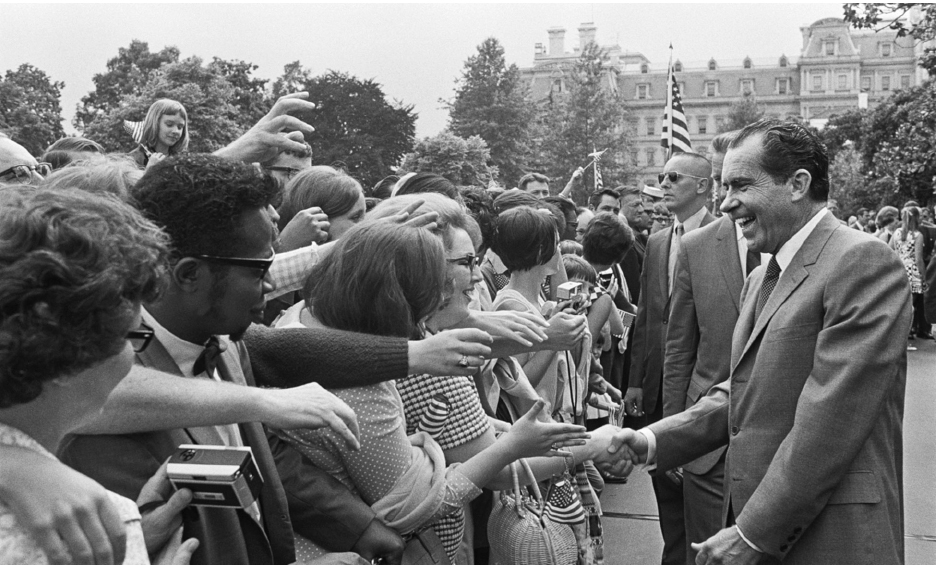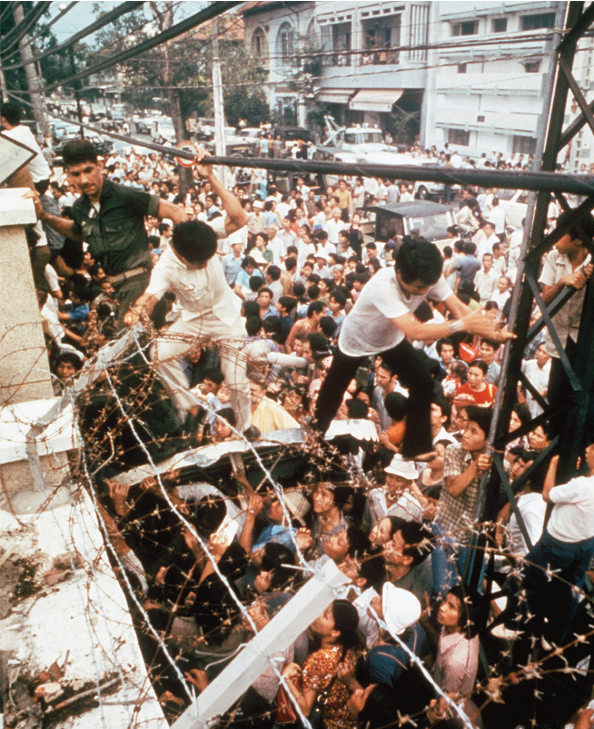Nixon in Vietnam
On the war in Vietnam, Nixon picked up where Johnson had left off. Cold War assumptions continued to dictate presidential policy. Abandoning Vietnam, Nixon insisted, would damage America’s “credibility” and make the country seem “a pitiful, helpless giant.” Nixon wanted peace, but only “peace with honor.” The North Vietnamese were not about to oblige him. The only outcome acceptable to them was a unified Vietnam under their control.

Vietnamization and Cambodia To neutralize criticism at home, Nixon began delegating the ground fighting to the South Vietnamese. Under this new policy of Vietnamization, American troop levels dropped from 543,000 in 1968 to 334,000 in 1971 to barely 24,000 by early 1973. American casualties dropped correspondingly. But the killing in Vietnam continued. As Ellsworth Bunker, the U.S. ambassador to Vietnam, noted cynically, it was just a matter of changing “the color of the bodies.”
Far from abating, however, the antiwar movement intensified. In November 1969, half a million demonstrators staged a huge protest in Washington called the Vietnam Moratorium. On April 30, 1970, as part of a secret bombing campaign against Vietcong supply lines, American troops destroyed enemy bases in neutral Cambodia. When news of the invasion of Cambodia came out, American campuses exploded in outrage — and, for the first time, students died. On May 4, 1970, at Kent State University in Ohio, panicky National Guardsmen fired into an antiwar rally, wounding eleven students and killing four. Less than two weeks later, at Jackson State College in Mississippi, Guardsmen stormed a dormitory, killing two black students. More than 450 colleges closed in protest. Across the country, the spring semester was essentially canceled.
My Lai Massacre Meanwhile, one of the worst atrocities of the war had become public. In 1968, U.S. Army troops had executed nearly five hundred people in the South Vietnamese village of My Lai, including a large number of women and children. The massacre was known only within the military until 1969, when journalist Seymour Hersh broke the story and photos of the massacre appeared in Life magazine, discrediting the United States around the world. Americans, Time observed, “must stand in the larger dock of guilt and human conscience.” Although high-ranking officers participated in the My Lai massacre and its cover-up, only one soldier, a low-ranking second lieutenant named William Calley, was convicted.
Believing that Calley had been made a fall guy for official U.S. policies that inevitably brought death to innocent civilians, a group called Vietnam Veterans Against the War publicized other atrocities committed by U.S. troops. In a controversial protest in 1971, they returned their combat medals at demonstrations outside the U.S. Capitol, literally hurling them onto the Capitol steps. “Here’s my merit badge for murder,” one vet said. Supporters of the war called these veterans cowardly and un-American, but their heartfelt antiwar protest exposed the deep personal torment that Vietnam had caused many soldiers.

Détente As protests continued at home, Nixon pursued two strategies to achieve his declared “peace with honor,” one diplomatic and the other brutal. First, he sought détente (a lessening of tensions) with the Soviet Union and a new openness with China. In a series of meetings between 1970 and 1972, Nixon and Soviet premier Leonid Brezhnev resolved tensions over Cuba and Berlin and signed the first Strategic Arms Limitation Treaty (SALT I), the latter a symbolic step toward ending the Cold War arms race. Heavily influenced by his national security advisor, the Harvard professor Henry Kissinger, Nixon believed that he could break the Cold War impasse that had kept the United States from productive dialogue with the Soviet Union.
Then, in 1972, Nixon visited China, becoming the first sitting U.S. president to do so. In a televised weeklong trip, the president pledged better relations with China and declared that the two nations — one capitalist, the other communist — could peacefully coexist. This was the man who had risen to prominence in the 1950s by railing against the Democrats for “losing” China and by hounding communists and fellow travelers. Indeed, the president’s impeccable anticommunist credentials gave him the political cover to travel to Beijing. He remarked genially to Mao: “Those on the right can do what those on the left only talk about.” Praised for his efforts to lessen Cold War tensions, Nixon also had tactical objectives in mind. He hoped that by befriending both the Soviet Union and China, he could play one against the other and strike a better deal over Vietnam at the ongoing peace talks in Paris. His second strategy, however, would prove less praiseworthy and cost more lives.

Exit America In April 1972, in an attempt to strengthen his negotiating position, Nixon ordered B-52 bombing raids against North Vietnam. A month later, he approved the mining of North Vietnamese ports, something Johnson had never dared to do. The North Vietnamese were not isolated, however: supplies from China and the Soviet Union continued, and the Vietcong fought on.
With the 1972 presidential election approaching, Nixon sent Kissinger back to the Paris peace talks, which had been initiated under Johnson. In a key concession, Kissinger accepted the presence of North Vietnamese troops in South Vietnam. North Vietnam then agreed to an interim arrangement whereby the South Vietnamese government in Saigon would stay in power while a special commission arranged a final settlement. With Kissinger’s announcement that “peace is at hand,” Nixon got the election lift he wanted, but the agreement was then sabotaged by General Nguyen Van Thieu, the South Vietnamese president. So Nixon, in one final spasm of bloodletting, unleashed the two-week “Christmas bombing,” the most intense of the entire war. On January 27, 1973, the two sides signed the Paris Peace Accords.
Nixon hoped that with massive U.S. aid, the Thieu regime might survive. But Congress was in revolt. It refused appropriations for bombing Cambodia after August 15, 1973, and gradually cut back aid to South Vietnam. In March 1975, North Vietnamese forces launched a final offensive, and on April 30, Vietnam was reunited. Saigon, the South Vietnamese capital, was renamed Ho Chi Minh City, after the founding father of the communist regime.
The collapse of South Vietnam in 1975 produced a powerful, and tragic, historical irony: an outcome little different from what would likely have resulted from the unification vote in 1954 (see “Vietnam” in Chapter 25). In other words, America’s most disastrous military adventure of the twentieth century barely altered the geopolitical realities in Southeast Asia. The Hanoi regime called itself communist but never intended to be a satellite of any country, least of all China, Vietnam’s ancient enemy.
Many paid a steep price for the Vietnam War. America’s Vietnamese friends lost jobs and property, spent years in “reeducation” camps, or had to flee the country. Millions of Vietnamese had died in a decade of war, which included some of the most intensive aerial bombing of the twentieth century. In bordering Cambodia, the maniacal Khmer Rouge, followers of Cambodia’s ruling Communist Party, took power and murdered 1.7 million people in bloody purges. And in the United States, more than 58,000 Americans had sacrificed their lives, and 300,000 had been wounded. On top of the war’s $150 billion price tag, slow-to-heal internal wounds divided the country, and Americans increasingly lost confidence in their political leaders.
COMPARE AND CONTRAST